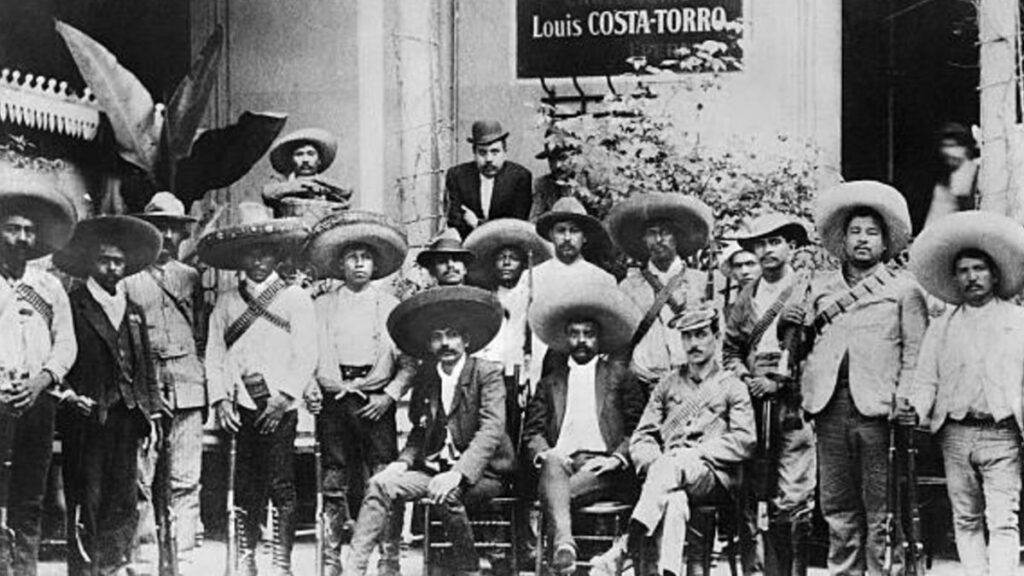
by Carlos Fazio
Released in October 1903 and unable to continue his organizing and campaigning in Mexico, Ricardo Flores Magón went into exile in Laredo, Texas, and then to St. Louis, Missouri, a refuge for anarchist and Marxist dissidents and rebels and anarcho-syndicalist migrants. There he became close friends with the Spanish libertarians Florencio Basora, Jaime Vidal and Pedro Esteve, and the Russian Emma Goldman. He studied and disseminated the works of anarchist theorists, such as Peter Kropotkin and Miguel Bakunin, which radicalized his reflections in the newspaper Regeneración on social transformation in Mexico.
Influenced by the methods of the Russian libertarian movement against the Czarist autocracy, Flores Magón proposed a social revolution of the poor people by armed means; Mexico could only change through the political-military defeat of General Díaz. From St. Louis, Missouri, he directed the network of contacts of the liberal groups in Mexico, led the formation of the Organizing Board of the Mexican Liberal Party (11/28/1905) and defined its political line. Hounded by US and Mexican agents, he went into exile in Toronto, Canada, and in July 1906 drafted the Program of the PLM (already illegal) and designed the revolutionary insurrectionary project, which included the purging and restructuring of the liberal clubs into a clandestine (conspiratorial) political organization with a centralized command in the junta, preparing the logistical conditions for the uprising (training, stockpiling of weapons) and the publication of Regeneración as a political-ideological and
He participated in the attempt to take Ciudad Juárez, Chihuahua, joined the liberal insurrection that began with the taking of Jiménez, Coahuila, and went hopping between Los Angeles, San Francisco and Sacramento. When Regeneración was shuttered, Flores Magón and his comrades created the newspaper Revolución. By then Porfirio Diaz was already offering 25 thousand dollars for his capture. In August 1907 Flores Magón was arrested in Los Angeles and was tried for violations of the Neutrality Laws and for conspiracy. He remained imprisoned for 18 months in the penitentiary of Florence, Arizona. In May 1908, President T. Roosevelt declared before the U.S. Congress that “the anarchist is the enemy of humanity […] the deepest degree of criminality,” and called for a ban on the use of the post office by anarchist publications, and an increase in the power of the Secret Service. Released in August 1910, in a rally in Los Angeles, Flores Magón shouted: “Long live social revolution!”
In 1910 there was an explosive class confrontation in Mexico: big landowners and capitalists vs. the proletariat and peasantry (96.6 percent of rural families were totally landless). At the head of a vanguard faction of industrialists, landowners, businessmen and northern regional caciques, Francisco I. Madero launched in October the Plan of San Luis1, and on November 5 the Liberal Party pointed out its political differences with the Anti-Re elelectionist Party. Considering Madero’s armed insurrectionary uprising to be individualistic, it decided to favor clandestine tasks and the reorganization of the party. On November 19, 1910, in Regeneración, Flores Magón reiterated that the two concepts of his slogan “land and freedom!” were the essence of the popular demands in the coming Revolution.
On November 20, the uprising began. With the help of Standard Oil and some treachery, Madero triumphed, who asked Zapata and Francisco Villa to disarm his troops. Diaz went into exile. The Magonistas were persecuted in Mexico and the US. On September 23, 1911, in a manifesto, RFM raised the anarcho-communist flag, and supported the revolutionary strikes of peons in Yucatan and the land seizures of Zapata in Morelos, of the Yaquis in Sonora and Chihuahua against Madero’s forces, of the Sotavento towns of Veracruz, and the indigenous communities in Jalisco, and called to take possession of factories, workshops, mines and foundries. For the PLM, the authority and the clergy were the mainstay of the inequity of capital. That is why it declared war on them. And while Zapata established the Morelos commune based on peasant traditions of self-government, the Magonistas established their commune in Baja California according to the anarchist principles of egalitarianism and direct democracy.
In early 1912 Flores Magón criticized Madero’s agrarian policy. And in an article entitled “A Tomar la Tierra,” (To Take the Land) he used the authority of Kropotkin -who supported the Mexican revolution- to insist that land is the basis of all revolution, of the advent of socialism and that “the agrarian problem in Mexico […] constitutes the backbone of the revolutionary movement.” RFM and PLM supported Emiliano Zapata. There are public documents of the Liberation Army of the South and personal communications from Zapata to Flores Magón.
In issue 262 of Regeneración, which was the last issue, RFM and Librado Rivera published a Manifesto that would cost them their lives. Both were accused of sedition. Considered a dangerous anarchist by the US Department of Justice, Ricardo Flores Magón was sentenced to 22 years in prison. On November 21, 1922, prisoner number 14,596 of the Leavenworth Penitentiary, in Kansas, died under strange circumstances in his cell. He was 49 years old. In Mexico, the defeated revolution would become the ideological banner that would legitimize the government of the bourgeoisie in the 20th century. Today, land is still concentrated in a few hands and the class war continues.
This article was published on November 14,2022 in La Jornada. https://www.jornada.com.mx/2022/11/14/opinion/023a1pol Translation by Schools for Chiapas.
